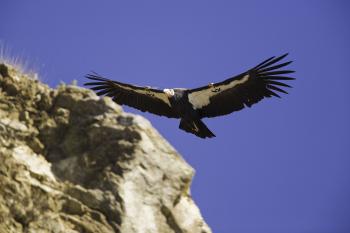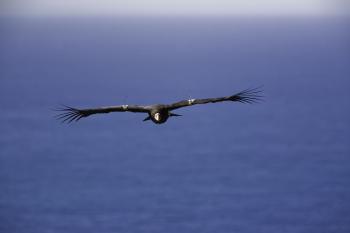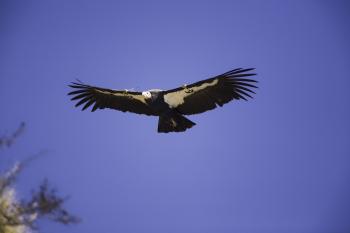California condors are one of few endangered species that are easy to see in the wild. My first “condor encounter” was at Pinnacles National Monument, ninety minutes south of San Jose. Since then, I have seen condors many times at Pinnacles and along the Big Sur coastline.
Captive bred California condors have been released at Pinnacles National Monument since 2003. The population dropped to just 22 condors in 1982, but thanks to efforts of wildlife biologists, captive breeding has added about 300 condors to that number. About half of the captive-bred condors have been re-introduced into their former ranges, along with a few older “mentor” birds.
Condors often roost overnight in trees along the ridge behind Pinnacles campground. The birds glide above the ridge at dusk, seeking the perfect snag. In morning, they preen and open their wings to the sun before taking flight. White triangles on the undersides of their wings are visible with binoculars. The largest North American land bird, condors in flight resemble small aircraft.

My goal was to see condors at closer range. Ranger Scott Sherbinski suggested that my best chance of a close encounter was early morning in the Pinnacles High Peaks. Condors sometimes roost in the High Peaks overnight. Having a scavenger’s slow metabolism, they spend the early hours warming in the sun until mid-morning thermals rise from the heated rocks.
My breath was visible in the chill air as I started the 1300-foot climb up Condor Gulch Trail to the High Peaks Trail. I stopped to scan the cliffs periodically. If the birds took wing before I reached the High Peaks, I would spot them as they left their roosting sites.
Then, as I rounded a bend on the west side of the High Peaks, three condors were perched on a large boulder jutting up from the trail. I was awestruck, barely able to breathe when I saw condors just 50 feet away.
The condors were warming in the early morning sunshine. They alternated opening their wings to the sun, and then preening themselves and each other. Their interactions were gentle and affectionate. One young bird had a peculiar “eyebrow” tuft of small feathers protruding from his forehead.

Fearful of startling the birds into flight, I sat motionless on a rock beside the trail. However, the birds were not intimidated by my presence. Being captive bred; most condors are habituated to humans. When they opened their wings, it was clear that I was no threat to them. Their wings span nearly ten feet. Their beaks can tear cowhide.
The morning air warmed, urging the birds aloft. Two other condors roosting in nearby pines briefly joined the three from the boulder. The birds circled to gain height, air whooshing as they flew over my head. I had to remind myself that condors are not predators.
Then the condors were gone. In just minutes, they were out of sight. Condors fly 50 miles an hour, traveling over 100 miles a day in their search for carrion. Pilots of small aircraft have reported condors at 10,000-foot altitudes.
The condors were likely heading to their customary feeding sites a few miles away. Although free to fly where they wish, biologists track the birds’ movements and place food in designated feeding sites. One feeding site is behind the ridge on the far side of the Pinnacles campground.
Lead from bullets in hunter shot game was a primary reason the condors nearly became extinct. Now that the population is recovering, biologists go to great lengths to keep the birds away from lead tainted meat. Cattle ranchers contribute stillborn calves, and biologists carry food to feeding sights under cover of darkness. Biologist Sayre Flanagan waits 10 minutes after the first star so the birds will not associate food with humans.
Watching condors is addictive. After experiencing them at close range in the High Peaks, I wanted to see larger groups. Flanagan told me about her favorite condor hangouts.

Larger groups of condors glide above Highway 1 in Big Sur. Updrafts from the coastal cliffs create a perfect condor highway. Condors cruise above Highway 1 from Nepenthe restaurant south to Julia Pfeiffer Burns State Park.
Sunny, breezy days are best for condor watching at the coast. On several occasions, I have seen over a dozen birds within an hour. Once, we saw eighteen at one time.
The Big Sur condor flock is larger and has more mature birds than the Pinnacles flock. Big Sur has a number of sexually mature birds with completely red heads, and the area is home to several mated pairs. They have produced condor chicks since 2006.
Condor romance occurs in winter, and the female lays a single egg laid a cave or hollow tree. The pair shares their parental duties, with the father sometimes a bit more attentive. Condor chicks grow rapidly, and a chick reaches the size of a turkey within a month. Chicks fledge around 5 months, but they remain dependent on their parents until 18 months of age.
One breezy Saturday, I glimpsed Condor 444, the first wild bred condor in Northern California in a century. Her head was still completely black, and the white triangles under her wings were still mottled. It will be several years before she develops the red head and snowy white wing patches of a mature condor.
Condor 444 enjoys a position of privilege in the Big Sur flock. Her father is a one of the senior birds, and his daughter has first choice at feeding time. Typical condor adolescence is much more competitive.
At six or seven years of age, Condor 444 will choose a mate. Big Sur’s many canyons provide perfect habitat for breeding condors, each pair selecting their own canyon. Pairs produce a single chick about every other year. The population will grow, and many more visitors will experience “condor encounters” of their own.
All photos by Bob Stefko and may not be used without permission.